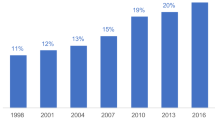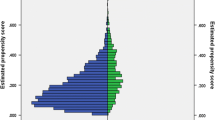Abstract
American students graduate from college with tens of thousands of dollars in debt, leading to substantial repayment burdens and potentially inefficient shifts in spending patterns and career choices. A political trend towards austerity coupled with the rising student debt make the effective allocation of federal higher education resources and manageable repayment burdens on graduates high priorities. In this article, we evaluate the net cost and distributional characteristics of four methods of US student loan repayment: the standard option, the income-based option, Pay-As-You-Earn option, and the proposed Student Loan Fairness Act. Conducting repayment simulations on 1993 and 2008 graduate debt levels for 502 constructed graduate salary paths, we find an inherent trade-off between public loan cost and repayment burdens; student loans that are more generous to poorer graduates are also those that are most expensive to the taxpayer. We conclude with a discussion of how the introduction of a targeted interest rate on income-contingent loans can circumvent this policy trade-off by extracting greater repayments from higher earning graduates.






Similar content being viewed by others
Notes
One caveat for the US debt write-off feature is that under the tax code, the write-off is considered taxable income (Lieber, 2012). Hence, graduates may lose 10,000 worth of debt after the write-off takes effect, but gain a significant tax bill.
The costs of loan subsidies also have substantial implications for the rationing of ICLs, via means-testing and/or limiting university places. While we acknowledge that these implications are important for student loan access, we do not discuss them here.
Borrowers can move between schemes during the repayment period, a potential complication not factored into this analysis. For example, a borrower could shift to standard repayment after 15 years of income-based repayment, significantly altering their total expected debt repayment and monthly repayment burden.
The SLFA has a provision that prevents unpaid interest from expanding the loan balance to beyond 10% of the amount borrowed (Department of Education, 2013).
Nearly all studies examining loan subsidies use the interest rate on long-term (10-year) government bonds as the government’s cost of borrowing (Dearden et al., 2008; Johnston and Barr, 2013).
Though US Stafford loans provide ‘subsidized’ and ‘unsubsidized’ interest rates, the former are not truly subsidized unless they are lower than government’s cost of borrowing — hence, it is possible for the US government to still earn a ‘profit’ off subsidized Stafford loans.
Pairwise correlation coefficients on year-to-year wages never drop below 0.77 with complete cases even during the biannual survey period, validating the use of interpolation.
References
Asher, L. (2012) ‘House budget proposal cuts Pell Grants and student loans: Makes college less affordable and student loans harder to repay’, Retrieved from The Institute for College Access and Success: http://projectonstudentdebt.org/files/pub/Ryan_Statement_Budget_3_26_12.pdf.
Barr, N. (2004) ‘Higher education funding’, Oxford Review of Economic Policy 20 (2): 264–283.
Barr, N. and Johnston, A. (2010) ‘Interest subsidies on student loans: A better class of drain’, Centre for the Economics of Education Working Paper DP 114, London School of Economics.
Bass, K. (2013) ‘H.R.1330: Student Loan Fairness Act’, Retrieved from Government Printing Office: http://www.gpo.gov/fdsys/pkg/BILLS-113hr1330ih/pdf/BILLS-113hr1330ih.pdf.
Baum, S. and Steele, P. (2010) ‘Who borrows most? Bachelor’s degree recipients with high levels of student debt’, Retrieved from The College Board: http://advocacy.collegeboard.org/sites/default/files/Trends-Who-Borrows-Most-Brief.pdf.
Brown, M. and Caldwell, S. (2013) ‘Young student loan borrowers retreat from housing and auto markets’, Retrieved from Federal Reserve Bank of New York: http://libertystreeteconomics.newyorkfed.org/2013/04/young-student-loan-borrowers-retreat-from-housing-and-auto-markets.html.
Bureau of Labor Statistics (2005) ‘The NLSY 79’, in Bureau of Labor Statistics (ed.) National Longitudinal Surveys Handbook, Bureau of Labor Statistics.
Callender, C. and Jackson, J. (2005) ‘Does the fear of debt deter students from higher education?’ Journal of Social Policy 34 (4): 509–540.
Chapman, B. (2006) Government Managing Risk: Income Contingent Loans for Social and Economic Progress, New York, NY: Routledge.
Chapman, B. and Lounkaew, K. (2010) ‘Income contingent student loans for Thailand: Alternatives compared’, Economics of Education Review 29 (5): 695–709.
Cigno, A. and Luporini, A. (2009) ‘Scholarships or student loans? Subsidizing higher education in the presence of moral hazard’, Journal of Public Economic Theory 11 (1): 55–87.
College Board Advocacy and Policy Center (2012) ‘Trends in student aid’, College Board. Retrieved from http://advocacy.collegeboard.org//sites/default/files/student-aid-2012-full-report.pdf.
Dearden, L., Fitzsimons, E., Goodman, A. and Kaplan, G. (2006) Estimating Lifetime Earnings Distributions Using Copulas, London, UK: Institute for Fiscal Studies.
Dearden, L., Fitzsimons, E., Goodman, A. and Kaplan, G. (2008) ‘Higher education reforms in England: The distributional effects and the shifting balance of costs’, Economic Journal 118 (526): 100–125.
Dente, B. and Piraino, N. (2011) ‘Models for determining the efficiency of student loans policies’, Journal of Higher Education Policy and Management 33 (4): 375–386.
Department of Education (2013) ‘Federal student aid’. Retrieved from http://studentaid.ed.gov/.
Department of Health and Human Services (2012) ‘Annual update of the HHS poverty guidelines’, Federal Register 77 (17): 4034–4035.
Deritis, C. (2011) ‘Student lending’s failing grade’. Retrieved from Moody’s Analytics: http://image.exct.net/lib/fefb127575640d/m/2/Student+Lendings+Failing+Grade.pdf.
Dynarski, S. and Wiederspan, M. (2012) ‘Student aid simplification: Looking back and looking ahead’, National Tax Journal 65 (1): 211–234.
Higgins, T. (2011) ‘Income support for higher education through income contingent loans’, Economic Papers 30 (4): 466–480.
Ionescu, F. (2009) ‘The federal student loan program: Quantitative implications for college enrollment and default rates’, Review of Economic Dynamics 12 (1): 205–231.
Johnston, A. and Barr, N. (2013) ‘Student loan reform, interest subsidies and costly technicalities: Lessons from the UK experience’, Journal of Higher Education Policy and Management 35 (2): 167–178.
Krueger, A. and Bowen, W. (1993) ‘Policy watch: Income-contingent college loans’, Journal of Economic Perspectives 7 (3): 193–201.
Lieber, R. (2012) ‘For student borrowers, relief now may mean a big tax bill later’, New York Times, 15 December 2012.
National Center for Education Statistics (2003) ‘Baccalaureate and Beyond. U.S. Department of Education’, Institute of Education Sciences, National Center for Education Statistics. Retrieved from National Center for Education Statistics: http://nces.ed.gov/surveys/bandb/.
National Center for Education Statistics (2009) ‘Baccalaureate and Beyond. U.S. Department of Education’, Institute of Education Sciences, National Center for Education Statistics. Retrieved from National Center for Education Statistics: http://nces.ed.gov/surveys/bandb/.
Organisation for Economic Co-Operation and Development (OECD) (2013) ‘Main economic indicators’. Retrieved from Organisation for Economic Co-Operation and Development: http://stats.oecd.org/mei/.
Primiceri, G. (2005) Why Inflation Rose and Fell: Policymakers’ Beliefs and U.S. Postwar Stabilization Policy, Princeton, NJ: Princeton University.
Rubinstein, Y. and Weiss, Y. (2006) ‘Post Schooling Wage Growth: Investment, Search and Learning’, in E. Hanushek and F. Welch (eds.) Handbook of the Economics of Education, Amsterdam: North Holland.
Scott-Clayton, J. (2012) ‘Information constraints and financial aid policy’, National Bureau of Economic Research WP. Retrieved from http://www.nber.org/papers/w17811.pdf.
Shen, H. and Ziderman, A. (2009) ‘Student loans repayment and recovery: International comparisons’, Higher Education 57 (3): 315–333.
Urban-Brookings Tax Policy Center (2011) ‘Baseline tables: Distribution of income and taxes’. Retrieved from Tax Policy Center: http://www.taxpolicycenter.org.
Vandenberghe, V. and Debande, O. (2008) ‘Refinancing Europe’s higher education through deferred and income-contingent loans: An empirical assessment using Belgian, German and UK data’, European Journal of Political Economy 24 (2): 364–386.
van der Klaauw, W., Brown, M., Haughwout, A., Lee, D. and Mabutas, M. (2012) ‘Grading student loans’. Retrieved from Federal Reserve Bank of New York: http://libertystreeteconomics.newyorkfed.org/2012/03/grading-student-loans.html.
Warren, E. (2013) ‘Senator Warren introduces legislation extending to students same interest rates enjoyed by big banks’. Retrieved from http://www.warren.senate.gov/?p=press_releaseandid=81.
Author information
Authors and Affiliations
Rights and permissions
About this article
Cite this article
Hauser, D., Johnston, A. Public Costs, Relative Subsidies, and Repayment Burdens of Federal US Student Loan Plans: Lessons for Reform. High Educ Policy 29, 89–107 (2016). https://doi.org/10.1057/hep.2014.25
Published:
Issue Date:
DOI: https://doi.org/10.1057/hep.2014.25




